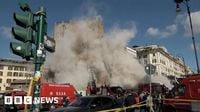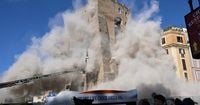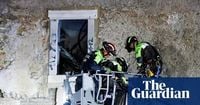In the heart of Rome, just steps from the bustling Colosseum and the ancient Via dei Fori Imperiali, a centuries-old monument became the scene of a harrowing tragedy on November 3, 2025. The Torre dei Conti, a 29-meter (95-foot) medieval tower built in the 13th century by Pope Innocent III, partially collapsed while undergoing extensive restoration work, trapping workers and sending shockwaves through the city and beyond.
The day began like any other for the construction crew tasked with revitalizing the Torre dei Conti, which has stood as a silent witness to Rome’s tumultuous history, from medieval intrigue to modern tourism. The tower, closed to the public since 2007, was in the final stages of a 6.9 million euro (nearly $8 million) restoration project, funded in part by the European Union. The work included conservation, installation of new electrical, lighting, and water systems, and plans for a museum dedicated to the Roman Imperial Forum’s most recent phases.
But just before midday, disaster struck. According to Reuters, the first collapse occurred around 10:30 GMT, when part of the tower’s central buttress on the southern side gave way, causing an underlying sloped base to fall. Roughly ninety minutes later, as firefighters were conducting a rescue operation using aerial ladders, another section of the stairwell and roof crumbled, sending clouds of dust billowing into the air and forcing rescuers to retreat in a hurry.
“I was working and then I heard something falling, and then I saw the tower collapse in a diagonal way,” recounted Queen Paglinawan, a 27-year-old employee at a neighboring gelato parlor, in an interview with The Associated Press. The sudden, dramatic failure of the ancient structure drew hundreds of onlookers, including tourists who had just left the Colosseum. Viktoria Braeu, a German student, recalled, “We were like, ‘It’s probably not long until it’s going to go down,’ and then it just started erupting.”
In the immediate aftermath, three workers were rescued unharmed from the site. But for two others, the situation was dire. One, a 64-year-old Romanian worker, was quickly pulled from the rubble and hospitalized with serious but not life-threatening head injuries, including a broken nose, as reported by RAI and Reuters. The other, Octay Stroici—also identified as a Romanian national—remained trapped beneath tons of debris.
The rescue operation that followed was nothing short of Herculean. About 140 firefighters, led by chief commander Adriano De Acutis, battled not just the weight of the rubble, but the constant threat of further collapse. “The operation lasted a long time because every time a part of the body was freed there was additional rubble that covered it,” explained Lamberto Giannini, Rome’s prefect, to reporters. Teams used cranes, telescopic aerial ladders, drones, and even giant tubes to suck rubble from the tower’s second-floor windows, working late into the night as the structure’s instability complicated every move.
Throughout the ordeal, there were moments of hope. Rome Mayor Roberto Gualtieri told reporters that Stroici was conscious, communicating with rescuers, and using an oxygen mask. “Rescuers were working with extreme caution in a very delicate extraction operation to avoid further collapses,” Gualtieri said, emphasizing the risks undertaken by the emergency teams. Images broadcast on local television showed rescuers loading Stroici onto a stretcher and lowering him to the ground via a telescopic ladder, before he was whisked away by ambulance.
Yet the joy of his extraction was heartbreakingly brief. Stroici, who had endured nearly eleven hours trapped beneath rubble, succumbed to his injuries soon after arriving at the hospital. Italian Prime Minister Giorgia Meloni expressed the nation’s grief in a statement released after midnight on November 4. “I express deep sorrow and condolences, on behalf of myself and the government, for the tragic loss of Octay Stroici, the worker who was killed in the collapse of the Torre dei Conti in Rome,” Meloni said, as reported by The Associated Press. “We are close to his family and colleagues at this time of unspeakable suffering.” Earlier, Meloni had voiced hope for a positive outcome, thanking the “law enforcement officers, firefighters, and rescue workers who are intervening with courage, professionalism, and dedication in this extremely difficult situation.”
The collapse has prompted swift action from Italian authorities. Prosecutors arrived at the scene during the ongoing rescue to open investigations into possible charges of negligent disaster and negligent injuries, a standard procedure in Italy even before specific suspects are identified. According to Corriere della Sera, the construction site was seized for further examination. Structural surveys and load tests had been carried out before the latest phase of renovation began in June 2025, and officials had declared the site safe to proceed—including asbestos removal and other critical updates. The current phase, costing about 400,000 euros ($460,000), was nearly complete at the time of the incident.
The Torre dei Conti’s turbulent history is well documented. Built as a family residence for Pope Innocent III, the tower was originally twice its current height but was reduced following a devastating earthquake in 1349 and further collapses in the 17th century. For a time, it housed city hall offices, but had not been in use since 2006. The most recent restoration aimed to return a piece of Rome’s layered past to the public, but now leaves the city grappling with questions about the preservation of its ancient monuments and the safety of those tasked with their care.
Despite the tragedy, praise for the rescue workers has been universal. Rome Mayor Gualtieri commended their bravery and selflessness, noting that they “placed their own lives at risk to try to save Mr. Stroici.” No firefighters were injured during the operation—a small mercy amid the sorrow.
As investigations continue and the city mourns, the collapse of the Torre dei Conti stands as a stark reminder of the fragility of Rome’s historical treasures and the human cost of preserving them. For now, the ancient tower remains cordoned off, its future uncertain, as authorities seek answers and families grieve the loss of a dedicated worker whose life was cut short beneath the stones of history.






